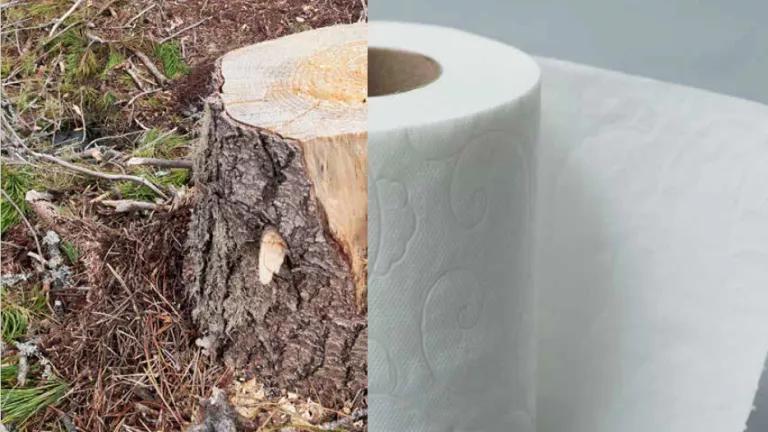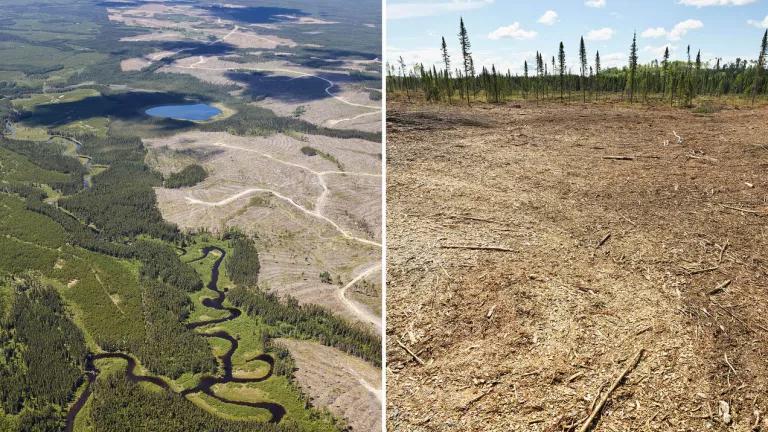Unrolling Charmin’s Sustainability Claims
The toilet paper giant, Charmin, makes a lot of claims about its environmental impact and commitments on its website, but how are they really doing?

Charmin is America’s leading toilet paper brand, but it’s at the back of the pack when it comes to sustainability. Two weeks ago, NRDC and Stand.earth released “The Issue with Tissue: How Americans are Flushing Forests Down the Toilet,” a report laying bare the disastrous impacts America’s tissue production is having on Canada’s boreal forests and other forest ecosystems around the world. Charmin is among the worst offenders, earning an F in the report’s scorecard, which grades household tissue brands based on their sustainability for forests. Charmin uses zero recycled content in its toilet paper, relying entirely on virgin fiber for its tissue products.
That may surprise you if you’ve visited Charmin’s website, where Procter & Gamble, Charmin’s manufacturer, makes many statements to give the impression that if you care about the environment, buying Charmin is a sustainable choice. Unfortunately, it's just greenwashing: Charmin toilet paper comes in part from the Canadian boreal forest, one of the most important forests in the world for Indigenous Peoples, wildlife, and the climate. The Canadian boreal is being logged at a rate of seven NHL hockey rinks a minute, largely due to destructive logging for products like Charmin.
Charmin’s website doesn’t paint the full picture of the environmental impacts of making toilet paper from virgin forest fiber, including the following:
- Virgin fiber toilet paper is terrible for the climate. Toilet paper made entirely from virgin fiber creates 3 times the carbon emissions as toilet paper made with 100% recycled content.
- The Canadian boreal is being rapidly clearcut, threatening wildlife like caribou, songbirds, and even bears not unlike Charmin’s mascots. This logging is driven in large part by logging to feed U.S. demand for products including for throwaway tissue and toilet paper.
- Virgin fiber toilet paper requires a caustic bleaching process that pollutes our waterways and our air, harming humans and wildlife. The production of pulp from virgin fiber generates twice as many hazardous air pollutants and 40 percent more sulfur dioxide as recycled tissue. These toxins can cause respiratory problems, acid rain, smog, eye and nose irritation, and possibly cancer.
Charmin has a lot of messaging on its website that obfuscates these impacts. But, in terms of substance, Charmin’s claims of environmental sustainability are toilet paper-thin:
- “100% of the pulp used to make our paper is certified by recognized organizations to ensure we only use responsibly managed sources”: Certification does not guarantee sustainability or responsible sourcing, and Procter & Gamble is far from discerning in the certifications it acquires. Procter & Gamble supports certification systems including SFI and PEFC that contain glaring loopholes and are a long way from guaranteeing forests are being harvested sustainably. The only certification system with any credibility is the Forest Stewardship Council (FSC), which, while not perfect, has the most stringent sustainability requirements by all measures. However, while Charmin includes the FSC logo on its packaging, it has a less robust form of FSC certification, called FSC-Mix certification. This is a far more relaxed standard than full FSC certification, failing to guarantee the sustainability of boreal caribou populations, the protection of intact forests, or that the wood is obtained with the free, prior, and informed consent of Indigenous Peoples.
Even were Charmin to transition to full FSC certification, this wouldn’t reduce the pressure its single-use products place on forests. Only transitioning away from forest content altogether will do that. In addition, tissue products made entirely from virgin fiber result in three times the carbon footprint as 100% recycled tissue products, which makes it clear why P&G needs to transition as swiftly as possible to using recycled content in Charmin.
- “For every tree we use, at least one is re-grown.” It’s a common misconception that replanting trees fully fixes the environmental impact of cutting down trees in the first place. The fact of the matter is that clearcutting does permanent damage to forests that replanting does not fix—scarring the landscape and changing the fragile balance of organisms and microorganisms in the soil, which reverberates all the way up the food chain. Often, wildlife like caribou do not return even to regrown clearcuts.
Furthermore, boreal trees grow very slowly, and it takes decades for newly replanted trees to capture the carbon that mature trees do. Clearcutting in the boreal forest allows the release of enormous amounts of greenhouse gases stored in the boreal’s carbon rich soils. In much of the boreal efforts to replant are not proving successful at replicating forests that resemble the biodiverse, carbon rich ancient forests that were clearcut.
- “We do not participate in any deforestation practices.” Another common misconception the Canadian government touts is that “deforestation” is the only bad logging practice. But "deforestation" is a very narrowly-defined term encompassing only the conversion of a forest into something else, like a farmland or roads. This means a forest can be clearcut and not technically be considered deforested! As a result, Charmin’s statement about deforestation has a very narrow meaning and certainly does not say that they’re not engaging in activities that severely harm the forest. You can read more about this here.
- “We use paper from fast-growing trees, like Eucalyptus, which helps quickly and sustainably replenish supply.” While we note some promising alternative fibers in our report (see p. 13 & 14), eucalyptus is unfortunately not one of them. Eucalyptus tends to be highly invasive and takes over in the areas where it’s planted, destroying native species and drastically altering ecosystems. Also, it is not necessarily sustainably grown. Many eucalyptus plantations require first clearcutting intact forests. Furthermore, Charmin fails to mention that they also purchase a large amount of pulp from forests, including Canada’s boreal forest (33% of the pulp for Procter & Gamble’s tissue and hygiene products comes from Canada), which is anything but fast-growing. In the best scenarios, it takes many decades for planted trees in the boreal to reach the same size as those they replaced - and there is growing evidence that in many places the boreal isn’t regenerating from clearcutting.
Any progress Charmin has made falls far short of what is needed to make its toilet paper sustainable. Ultimately, Charmin still sends trees from invaluable forests like the boreal to an ignoble fate in our bathrooms, perpetuating a highly destructive, dangerous tree-to-toilet pipeline.
We have called on Charmin to transition to using recycled materials and to stop sourcing from the ancient forests that are critical habitat for Canada’s boreal caribou, but they have failed to act. Lend your voice here and tell Charmin that, rather than resting on questionable laurels, the brand needs to adapt to the environmental crisis we are facing in the 21st century and embrace existing solutions by incorporating recycled content into their products. Anything less is wasteful, outmoded, and unacceptable.





